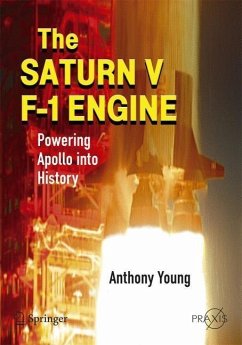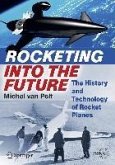When the mighty Rocketdyne F-1 engine was conceived in the late 1950s for the U.S. Air Force, it had no defined mission and there was no launch vehicle it could power. It was a bold concept to push the technological envelope of rocket propulsion in order to put massive payloads into Earth orbit. Few realized at the time that the F-1 would one day propel American astronauts to the Moon. In The Saturn V F-1 Engine, Anthony Young tells the amazing story of unbridled vision, bold engineering, explosive failures during testing, unrelenting persistence to find solutions, and ultimate success in launching the Saturn V with a 100 percent success rate. The book
The F-1 engine remains the high point in U.S. liquid rocket propulsion - it represents a period in American history when nothing was impossible.
- contains personal interviews with many Rocketdyne and NASA personnel involved in the engine's design, development, testing and production;
- is lavishly illustrated with black-and-white and color photographs, many never previously published
- is the first complete history of the most powerful rocket engine ever built.
The F-1 engine remains the high point in U.S. liquid rocket propulsion - it represents a period in American history when nothing was impossible.
Dieser Download kann aus rechtlichen Gründen nur mit Rechnungsadresse in A, B, BG, CY, CZ, D, DK, EW, E, FIN, F, GR, HR, H, IRL, I, LT, L, LR, M, NL, PL, P, R, S, SLO, SK ausgeliefert werden.
From the reviews:
"The author provides good descriptions of engine components and manufacturing and the contributions that Rocketdyne, Boeing, and the NASA Marshall Space Flight Center made to the F-1. The book also covers engine testing, the first Saturn V stage, and the Apollo launches. ... The book contains 32 excellently printed full-page color photographs and numerous black-and-white photos and diagrams. An important contribution to the history of technology and the history of space exploration. Summing Up: Highly recommended. All collections." (A. M. Strauss, Choice, Vol. 46 (10), June, 2009)
"Over the years there have been a few books published about the Saturn rockets, but here's one that focuses solely on the business end of the Saturn V - the F-1 rocket engine, still the largest such engine ever developed. ... The book is profusely illustrated throughout, and there's a nice section of colour plates as well. All in all, a valuable addition to the literature of both rocket development and the Apollo programme." (Liftoff, Issue 257, May-June, 2010)
"The author provides good descriptions of engine components and manufacturing and the contributions that Rocketdyne, Boeing, and the NASA Marshall Space Flight Center made to the F-1. The book also covers engine testing, the first Saturn V stage, and the Apollo launches. ... The book contains 32 excellently printed full-page color photographs and numerous black-and-white photos and diagrams. An important contribution to the history of technology and the history of space exploration. Summing Up: Highly recommended. All collections." (A. M. Strauss, Choice, Vol. 46 (10), June, 2009)
"Over the years there have been a few books published about the Saturn rockets, but here's one that focuses solely on the business end of the Saturn V - the F-1 rocket engine, still the largest such engine ever developed. ... The book is profusely illustrated throughout, and there's a nice section of colour plates as well. All in all, a valuable addition to the literature of both rocket development and the Apollo programme." (Liftoff, Issue 257, May-June, 2010)









